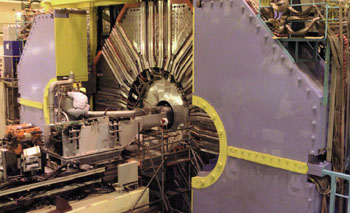
On 1 June, after five years of planning and five years of construction, the BELLE detector recorded its first B meson events at the KEKB electronpositron B-factory in Tsukuba, Japan. During this first run, all BELLE systems were active, including the electron-identification software, which saw a CP-violating candidate decay into a J/psi and a short-lived kaon, with the former producing an electronpositron pair. This marks the real start of the KEKB factory and its quest to investigate the puzzle of CP violation.
The KEKB collider is an energy-asymmetric collider, its two rings handling 3.5 GeV positrons and 8 GeV electrons in the old 3 km TRISTAN tunnel. The injection linac was upgraded from that used for TRISTAN and was ready long before the commissioning of the rings began last December.
Beams were first stored in the electron ring (HER) on 13 December and in the positron ring (LER) on 14 January. After several interruptions, scheduled and unscheduled, the stored currents rose to 500 mA, corresponding to 20 and 50% of the designed values of LER and HER respectively, by mid-April.
The limiting factors are currently believed to be radiofrequency power for HER and vertical beam blow-up due to a multibunch instability. Of the two major unscheduled breaks experienced so far, the first was provoked by a false fire alarm in the tunnel. The second came when a spot of the vacuum chamber was melted by synchrotron radiation from the final focusing quadrupole during trials of a large angle bump orbit. The chamber was quickly replaced with one of heat-resistant design.

Commissioning was halted from 1 May for the installation of the BELLE detector, which crept into the collision point at a speed of 0.5 m/min, taking about 30 min to complete the “long trip”. Beam tuning resumed on 25 May and collisions were achieved on 1 June.
Initially, currents in both beams were kept below 20 mA to guard against radiation damage to the BELLE detector’s silicon vertex detector. Beam currents have subsequently been increased to more than 100 mA.
Prior to establishing collisions, a potentially harmful 0.45 Hz vertical beam vibration was observed in the low-energy positron ring. This was tracked down to tiny magnetic fields produced by current leads running between the power supply and the main ring of KEK’s 12 GeV proton synchrotron. These leads pass through a channel above the KEKB tunnel 8 m from the beam pipes.
The proton synchrotron is currently providing a neutrino beam directed at the Super-Kamiokande detector, 250 km distant, for the high-priority K2K experiment, which is searching for confirmatory evidence for the neutrino oscillations reported by the Super-K group last year.
Fortunately for BELLE, KEKB’s first time slot for electronpositron collisions coincided with a maintenance day for the proton synchrotron, resulting in the successful test run of 1 June The troublesome stray fields have since been reduced substantially by reconfiguring the proton synchrotron’s power leads.
In addition to providing BELLE data, the successful test run verifies a number of novel KEKB design features the finite-angle beam crossing did not result in beam-destroying synchro-betatron oscillations, and the growth times of the instability due to fundamental mode shifts in the ARES energy storage radiofrequency cavities were longer than the natural damping times of the storage rings.
KEKB has achieved stable collisions with design values of single-bunch currents. The next goal is to increase the number of bunches and boost the luminosity towards the design figure of 1034 cm2 s1. As the number of ampere-hours of integrated beam current in the machine increases, the vacuum in the beam pipe continues to improve and background conditions in the BELLE detector decrease.
Currently the luminosity is estimated to be 2 x 1031 cm-2 s-1, with tens of hadron events collected every few hours. This performance should soon increase and open up a rich programme of studies of B meson decays to probe the puzzle of CP violation.





